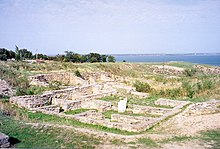 The ruins of Olbia | |
| Alternative name | Olbia |
|---|---|
| Location | Parutyne, Mykolaiv Oblast, Ukraine |
| Coordinates | 46°41′33″N 31°54′13″E / 46.69250°N 31.90361°E |
| Type | Settlement |
| Length | 1 mi (1.6 km) |
| Width | 0.5 mi (0.80 km) |
| Area | 50 ha (120 acres) |
| History | |
| Builder | Settlers from Miletus |
| Founded | 7th century BC |
| Abandoned | 4th century AD |
| Periods | Archaic Greek to Roman Imperial |
| Cultures | Greek, Roman |
| Site notes | |
| Excavation dates | 1901–1915, 1924–1926 |
| Archaeologists | Boris Farmakovsky |
| Condition | Ruined |
Pontic Olbia (Ancient Greek: Ὀλβία Ποντική; Ukrainian: Ольвія, romanized: Olviia) or simply Olbia is an archaeological site of an ancient Greek city on the shore of the Southern Bug estuary (Hypanis or Ὕπανις,) in Ukraine, near the village of Parutyne. The archaeological site is protected as the National Historic and Archaeological Preserve. The preserve is a research and science institute of the National Academy of Sciences of Ukraine. In 1938–1993 it was part of the NASU Institute of Archaeology as a department.
The Hellenic city was founded in the 7th century BC by colonists from Miletus. Its harbour was one of the main emporia on the Black Sea for the export of cereals, fish, and slaves to Greece, and for the import of Attic goods to Scythia.[1]
- ^ Encyclopedia of Ancient Greece (ed. by Nigel Guy Wilson). Routledge (UK), 2005. ISBN 0-415-97334-1. Page 510.
